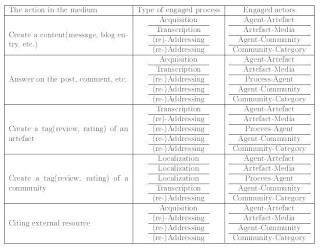Several days ago i read somewhere that experiences influence our emotions. That is a direct alarm for me to summarize that all operations we are performing in our life, at least virtual one, play roles in emotions we are producing. Therefore I can conclude that those two notions, operations (participatory design methods, media processes, user actions - call them as you want) and emotions are connected notions. One can either follow the actions accompanied with emotions like it was done in Situation Modeling and Smart Context Retrieval with Semantic Web Technology and Conflict Resolution or differentiate between those as different actors of a community system (when presented like an actor network model).
Some scholars follow the experiences through ontologies that help to summarize semantics in an ontology object and highlight connections between different entries. The approach applied in PALADIN: A Pattern Based Approach to Knowledge Discovery in Digital Social Networks uses a pattern approach. One can say that patterns can be like ontology objects when those are defined by the semantics and relationships between patterns are specified. Although a higher level of abstaction(for ontologies are concepts) is lacking, it is a moot point. The hierarchy can be specified by relations. Patterns exceed onlologies by a relatively easy language. So that it is natural for a user to construct a semantic knowledge base for his needs.



